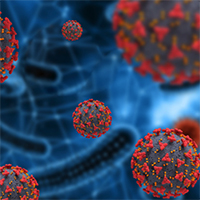Role of awake prone positioning in patients with moderate-to-severe COVID-19: an experience from a developing country

Submitted: August 11, 2020
Accepted: December 1, 2020
Published: March 5, 2021
Accepted: December 1, 2020
Abstract Views: 3821
PDF: 1869
Publisher's note
All claims expressed in this article are solely those of the authors and do not necessarily represent those of their affiliated organizations, or those of the publisher, the editors and the reviewers. Any product that may be evaluated in this article or claim that may be made by its manufacturer is not guaranteed or endorsed by the publisher.
All claims expressed in this article are solely those of the authors and do not necessarily represent those of their affiliated organizations, or those of the publisher, the editors and the reviewers. Any product that may be evaluated in this article or claim that may be made by its manufacturer is not guaranteed or endorsed by the publisher.
Similar Articles
- Amrutha S, Komaldeep Kaur, Deepak Aggarwal, Mandeep Kaur Sodhi, Shivani Jaswal, Varinder Saini, Serial evaluation of antibody titres in patients recovered from COVID-19 and their correlation with disease severity , Monaldi Archives for Chest Disease: Vol. 94 No. 4 (2024)
- Branko Beronja, Aleksandra Karan, Biljana Lukic, Ivana Milosevic, Jelena Dotlic, Tatjana Gazibara, Smoking patterns and outcomes of severe sars-CoV-2 infection: a retrospective cohort study , Monaldi Archives for Chest Disease: Early Access
- Neeta Singla, Amitesh Gupta, U.K. Khalid, Ravindra Kumar Dewan, Rupak Singla, Clinical profile, risk factors, disease severity, and outcome for COVID-19 disease in patients with tuberculosis on treatment under the National Tuberculosis Elimination Program: a cohort of 1400 patients , Monaldi Archives for Chest Disease: Early Access
- Roberto F.E. Pedretti, Francesco Fattirolli, Raffaele Griffo, Marco Ambrosetti, Elisabetta Angelino, Silvia Brazzo, Ugo Corrà , Nicolò Dasseni, Pompilio Faggiano, Giuseppe Favretto, Oreste Febo, Marina Ferrari, Francesco Giallauria, Cesare Greco, Manuela Iannucci, Maria Teresa La Rovere, Mario Mallardo, Antonio Mazza, Massimo Piepoli, Carmine Riccio, Simonetta Scalvini, Luigi Tavazzi, Pier Luigi Temporelli, Gian Francesco Mureddu, Cardiac Prevention and Rehabilitation “3.0â€: From acute to chronic phase. Position Paper of the ltalian Association for Cardiovascular Prevention and Rehabilitation (GICR-IACPR) , Monaldi Archives for Chest Disease: Vol. 88 No. 3 (2018)
- Sryma PB, Saurabh Mittal, Karan Madan, Anant Mohan, Pawan Tiwari, Vijay Hadda, Ravindra Mohan Pandey, Randeep Guleria, Awake prone positioning in non-intubated patients for the management of hypoxemia in COVID-19: A systematic review and meta-analysis , Monaldi Archives for Chest Disease: Vol. 91 No. 2 (2021)
- Matteo Petroncini, Leonardo Valentini, Piergiorgio Solli, Pietro Bertoglio, Giant lung bulla as a late-onset complication of mild SARS-CoV-2 pneumonia , Monaldi Archives for Chest Disease: Vol. 94 No. 3 (2024)
- Unnati Desai, Ketaki Utpat, Aravind Raj, The impact of the COVID-19 pandemic on the profile of interstitial lung disease presenting to the pulmonary medicine department of a tertiary care center in western India , Monaldi Archives for Chest Disease: Early Access
- Marinella Sommaruga, Elisabetta Angelino, Paola Della Porta, Mara Abatello, Giacomo Baiardo, Gianluigi Balestroni, Ornella Bettinardi, Edward Callus, Chiara Ciracì, Ombretta Omodeo, Claudia Rizza, Paolo Michielin, Marco Ambrosetti, Raffaele Griffo, Roberto F.E. Pedretti, Antonia Pierobon, Best practice in psychological activities in cardiovascular prevention and rehabilitation: Position Paper , Monaldi Archives for Chest Disease: Vol. 88 No. 2 (2018)
- Maya Gopalakrishnan, Satyendra Khichar, Suman Saurabh, Parag Vijayvergia, Karthikeyan Thangaraju, Swapnil Tripathi, Harshavardhan V. Devarakonda, Akhilesh Kumar , Pranav S. Kumar, Mahendra Kumar Garg , Effectiveness of early awake self proning strategy in non-intubated patients with COVID-19 hypoxemia: an open-labelled randomized clinical trial from Jodhpur, India , Monaldi Archives for Chest Disease: Vol. 93 No. 4 (2023)
- Angelica Cersosimo, Mattia Di Pasquale, Gianmarco Arabia, Marco Metra, Enrico Vizzardi, COVID myocarditis: a review of the literature , Monaldi Archives for Chest Disease: Vol. 94 No. 4 (2024)
You may also start an advanced similarity search for this article.

 https://doi.org/10.4081/monaldi.2021.1561
https://doi.org/10.4081/monaldi.2021.1561





